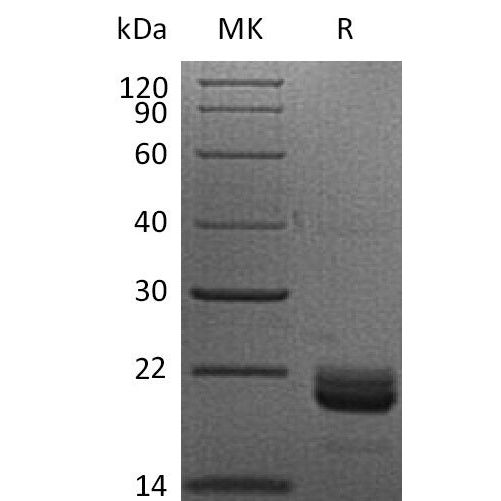Product Details
Product Details
Product Specification
| Species | Human |
| Synonyms | Tumor necrosis factor ligand superfamily member 14; Herpes virus entry mediator ligand; TNFSF14; HVEM-L; LIGHT |
| Accession | AAC39563.1 |
| Amino Acid Sequence | Leu83-Val240 |
| Expression System | HEK293 |
| Molecular Weight |
18.2 KDa
|
| Purity | >95% by SDS-PAGE |
| Endotoxin | <1EU/μg |
| Conjugation | Unconjugated |
| Tag | His Tag |
| Physical Appearance | Lyophilized Powder |
| Storage Buffer | PBS, pH 7.4. |
| Reconstitution |
|
| Stability & Storage |
|
Background
Human TNFSF14 Protein, also known as LIGHT, belongs to a member of the tumor necrosis factor (TNF) ligand family. It can bind to NFRSF3/LTBR. It is a ligand for TNFRSF14, which is a member of the tumor necrosis factor receptor superfamily, and it is also known as a herpesvirus entry mediator ligand (HVEML). TNFSF14 encodes a protein with a 37 aa cytoplasmic domain, 21aa transmembrane domain and 182 aa extracellular region. The gene is predominantly expressed in the spleen and also found in the brain. Weakly expressed in peripheral lymphoid tissues and in heart, placenta, liver, lung, appendix, and kidney, and no expression seen in fetal tissues, endocrine glands, or nonhematopoietic tumor lines. TNFSF14 protein was found to probably function as a costimulatory factor for the activation of lymphoid cells and as a deterrent to infection by herpesvirus. Studies have shown that this protein can prevent tumor necrosis factor alpha mediated apoptosis in primary hepatocyte. Two alternatively spliced transcript variant encoding distinct isoforms have been reported.
Picture
Picture
SDS-PAGE



